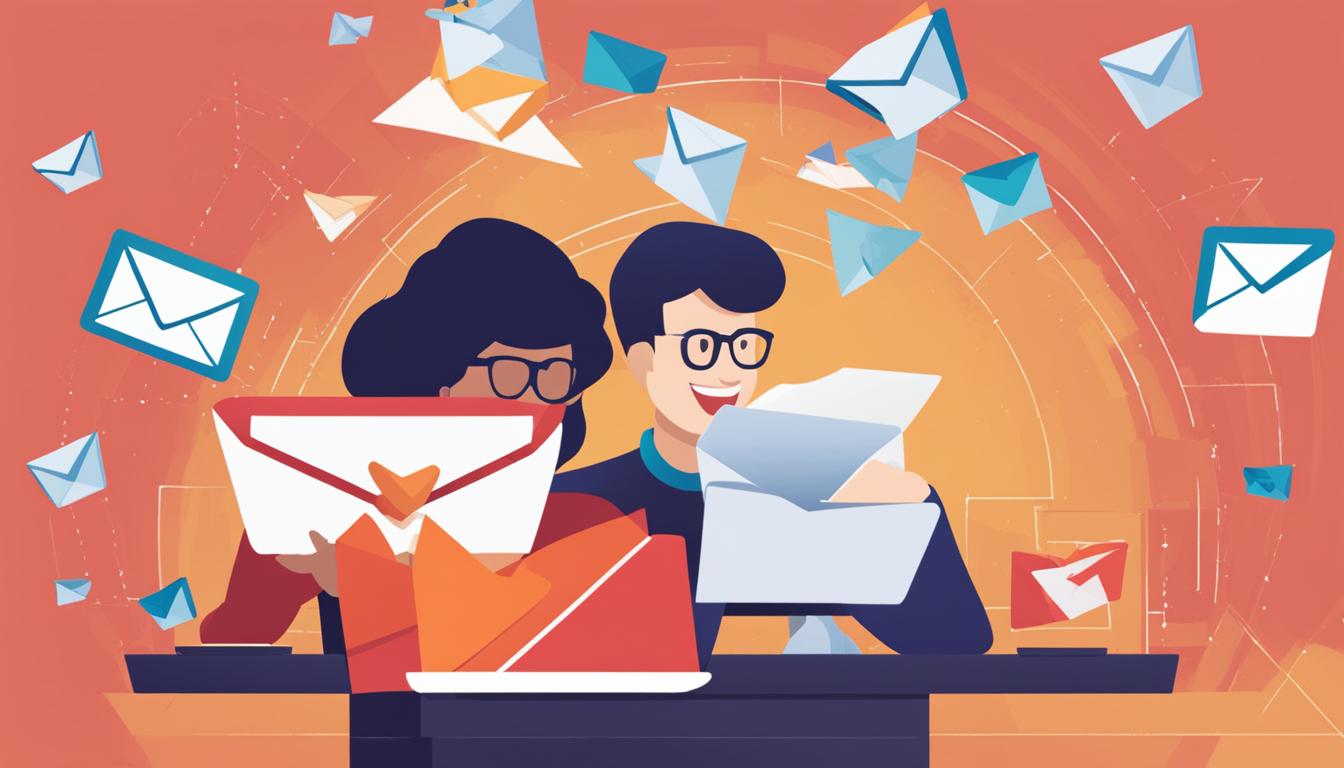How to Craft Emails That Get Opened?
Welcome to the world of email marketing. In today’s digital age, email is one of the most effective communication channels to connect with your audience. But, how can you ensure that your emails stand out in a cluttered inbox and get opened?
In this article, we will share with you strategies and tips to craft emails that are compelling, engaging, and drive open rates. Whether you’re a business owner, marketer, or an individual looking to improve your email communication, these email writing tips and effective email strategies will help you achieve your goals.
Key Takeaways:
- Learn the importance of crafting compelling emails in email marketing.
- Understand the fundamentals of effective email communication, including tone, clarity, and credibility.
- Discover how to create captivating subject lines that grab the reader’s attention.
- Explore techniques for writing engaging email content that captivates the reader.
- Learn how to craft effective calls to action (CTAs) to increase response rates.
Understanding Email Communication: Strategies for Success
When it comes to professional emails, communication is key. From your tone to your email etiquette, every aspect of your message should be carefully crafted to ensure clarity and credibility. Here are some tips to help you master the art of effective email communication:
Professional Email: Setting the Tone
One of the most important aspects of professional email communication is your tone. You want to come across as confident and approachable, but also respectful and professional. Avoid using informal language or slang, and always address the recipient formally, unless instructed otherwise.
Example: “Dear Ms. Smith” instead of “Hey there!”
Email Etiquette: Following Best Practices
Proper email etiquette is essential to maintaining a professional image. Make sure to proofread your emails for grammar and spelling errors, and avoid using ALL CAPS or excessive punctuation, which can come across as aggressive. It’s also important to respond to emails in a timely manner, so the recipient knows you value their input.
Clarity: Getting Your Message Across
Clarity is key when it comes to email communication. Keep your message concise and to the point, avoiding lengthy paragraphs or complex sentences. Use bullet points or numbered lists to break up text and make your message easier to read, and consider using images to illustrate your points where possible.
“The single biggest problem with communication is the illusion that it has taken place.” – George Bernard Shaw
Credibility: Establishing Trust
Finally, it’s important to establish credibility with your email communication. Make sure your messaging is honest and transparent, and always follow through on any promises or commitments made in your emails. Remember that every email you send is a reflection of your professionalism and credibility.
By following these email communication strategies, you can ensure that your emails are not only effective, but that they also leave a positive impression on your recipients.
Crafting Captivating Subject Lines: Grabbing Attention from the Start
When it comes to email marketing, the subject line is the first thing your audience sees. Therefore, crafting compelling email subject lines is essential to enhancing email open rates. Here are some tips to help you create captivating subject lines:
- Keep it short and sweet: Your subject line should be concise and to the point. A study by HubSpot found that subject lines with less than 50 characters had higher open rates than longer ones.
- Make it relevant: Your subject line should accurately reflect the content of your email. This helps to ensure that your readers aren’t disappointed and potentially unsubscribe.
- Personalize it: Use the recipient’s name or other personal information in the subject line to make it more engaging. A report by Experian found that personalized subject lines had a 29% higher open rate.
- Create a sense of urgency: Encourage your readers to take action by creating a sense of urgency in your subject line. For example, use phrases like “Limited Time Offer” or “Ending Soon” to encourage quick action.
- Use attention-grabbing language: Use powerful words and phrases that capture attention and evoke emotions. Some examples include “Exclusive”, “New”, “Free”, and “Now”.
Crafting captivating subject lines takes practice, but the effort is worth it when you see an increase in email open rates. Keep these tips in mind as you create your next email campaign.

Writing Engaging Email Content: Hooking Your Audience
Writing compelling email content is crucial to keep your audience engaged and interested in your message. When crafting your email content, keep the following tips in mind:
- Personalization: When addressing your audience, use their names and personalize your message. This will help to create a connection and make them more likely to read your entire email.
- Readability: Use short paragraphs and concise sentences when writing your email content. Break up your email with headings and bullet points to make it easier to read.
- Visuals: Incorporate visual elements such as images or videos to make your email more visually appealing and break up text-heavy sections.
- Call to Action: Include a clear call to action in your email content to encourage your audience to take the desired action.
- Value: Provide value to your audience by sharing information or offering a solution to a problem they may be facing. This will help establish trust and keep them engaged.
Remember to keep your audience in mind while writing your email content. Use a friendly and conversational tone to maintain their interest and keep them engaged with your message. By following these tips, you can write engaging email content that hooks your audience and drives action.
Mastering the Call to Action: Driving Desired Responses
The call to action (CTA) is the driving force behind an effective email. A clear and compelling CTA encourages your reader to take the desired action, whether it’s signing up for a newsletter, making a purchase, or scheduling a consultation.
When crafting your CTA, keep in mind the following:
- Be concise and specific with your language.
- Use action-oriented verbs that inspire immediate action, such as “register,” “subscribe,” or “buy.”
- Place the CTA prominently in the email, such as at the end of the message or in a button format.
Additionally, it’s important to follow professional email etiquette when crafting your CTA. Avoid using language that may come across as pushy or aggressive, such as “act now” or “limited time offer.” Instead, opt for a more conversational tone that encourages engagement without pressuring the reader.
Keep in mind that the success of your CTA relies heavily on the overall tone and messaging of the email. Ensure that your email provides a clear value proposition and is personalized to your reader’s interests before presenting your CTA.
Monitor your response rate to determine the effectiveness of your CTA and make adjustments as needed. By mastering the art of the CTA, you can drive desired responses and increase overall engagement with your emails.

“A clear and compelling CTA encourages your reader to take the desired action, whether it’s signing up for a newsletter, making a purchase, or scheduling a consultation.”
Polishing Your Professional Signature: Leaving A Lasting Impression
When it comes to email etiquette, your professional signature is often overlooked. However, it is an essential component of your email communication and can leave a lasting impression on your recipients.
A professional signature should include relevant information about you and your business. This may include your name, job title, company name, phone number, and website. You can also include social media links and a call-to-action (CTA) that encourages recipients to take the next step.
When designing your signature, keep in mind that simplicity is key. Use a font that is easy to read and avoid using too many colors or images that may make your signature look cluttered. Make sure your signature is in line with your branding, so it’s easily recognizable.
It’s also essential to follow email etiquette when it comes to professional signatures. Make sure your signature is not too long or too short and avoid using quotes or images that may be offensive.
Having a professional signature is an excellent way to showcase your credibility and professionalism in emails. By creating a memorable and informative signature, you can leave a lasting impression on your recipients and increase your chances of being remembered and contacted in the future.
Professional signature can leave a lasting impression on the recipient.
Exploring Examples of Successful Content Marketing Campaigns
Optimizing Email Formatting: Enhancing Readability and Impact
When it comes to crafting effective emails, formatting is crucial to enhance readability and impact. The way you structure an email can make all the difference in whether or not it gets read or, even worse, ends up in the trash. In this section, we’ll cover some best practices for optimizing email formatting to ensure your message gets across loud and clear.
Consider the Purpose of Your Email
Before jumping into formatting, it’s important to understand the purpose of your email. Are you sending a business proposal, a follow-up, or a newsletter? The purpose of your email should dictate its structure and design. For example, a newsletter might include a table of contents with links to different sections of the email, while a business proposal might have a more formal structure with clear headings and bullet points.
Use Clear and Concise Headings
Speaking of headings, they are a fantastic way to help break up an email and make it more readable. Use clear and concise headings that accurately reflect the content that follows. When using headings, consider using the H3 tag for subheadings. For example:
“Here’s a sample heading for a business proposal email:”
Introduction
Thank you for your interest in our business proposal. This document outlines the details of our proposal and includes all relevant information to make an informed decision.
Start earning effortlessly! Claim your $3 bonus and monetize your unused data with Honeygain. It’s simple, secure, and smart.
Claim Nowand watch your balance grow! 🍯💸
Business Proposal Summary
Our proposal includes…
Investment and Returns
Here’s a breakdown of the investment required and potential returns…
Use Formatting Techniques to Emphasize Key Points
When it comes to email formatting, less is often more. Use formatting techniques like bold, italics, and underline sparingly and only to emphasize key points. For example, you might use bold text to highlight a deadline or italics to emphasize a specific benefit to the reader.
Consider the Readability of Your Email
In addition to formatting, the readability of your email is critical to ensuring your message is understood. Use short paragraphs and bullet points to break up large blocks of text. Consider the font size and typeface to ensure it’s easy to read, and avoid using multiple colors or backgrounds that might distract from the content.
Include Relevant Images
Images can be a powerful way to convey information and break up text-heavy emails. When using images, be sure they are relevant and add value to the content. For example, you might include a screenshot of a new product or service you’re offering, or an infographic that summarizes key points.
Scheduling and Follow-ups: Timing is Everything for Maximum Impact
One of the biggest challenges of email management is timing. When do you schedule emails? How often do you follow-up? What do you do if you don’t receive a response?
Timing is everything in email communication. If you send an email at the wrong time, it might get lost in a sea of other emails or ignored entirely. On the other hand, sending an email at the right time can significantly increase the chances of it being read and acted upon. So, how do you schedule your emails effectively?
Establish a routine
Establishing a routine for sending emails can help you stay consistent and ensure that your messages are delivered at the right time. Consider setting aside specific times of the day or week for checking and sending emails. This not only helps you stay on top of your inbox but also gives your recipients a sense of predictability in your communication.
Follow-up effectively
Following up on emails is a crucial part of email communication, but it’s important to do it strategically. If you don’t receive a response to an email, don’t bombard your recipient with multiple follow-ups. Instead, give them some time to respond – a week or two is usually sufficient – and then follow-up with a polite reminder.
When following up, it’s essential to be persistent but also respectful of your recipient’s time. If you’re not receiving a response, consider changing your approach or reaching out through a different channel.
Manage response time
Response time is an essential aspect of email management. Responding promptly to emails can help you maintain a good relationship with your recipients and demonstrate your professionalism. However, it’s also important to manage your response time effectively. If you’re swamped with emails, consider using tools like email filters and canned responses to prioritize and automate your replies.
Use email follow-up techniques
There are several email follow-up techniques that you can use to increase the chances of your messages being read and acted upon. These include:
- Personalizing your follow-up messages
- Adding a sense of urgency to your messages
- Providing value in your follow-up messages
By using these techniques, you can make your follow-up messages more compelling and increase the chances of receiving a response.
Remember, timing is everything when it comes to email communication. By establishing a routine, following up effectively, managing your response time, and using email follow-up techniques, you can ensure that your messages are delivered at the right time and receive maximum impact.
Perfecting Grammar and Spelling: A Must for Professional Emails
Now that you understand the importance of maintaining a professional tone in your emails, it’s time to focus on perfecting your grammar and spelling. Poor grammar and spelling not only reflect negatively on your writing skills but also on your professionalism.
Before clicking the send button, make sure to conduct a thorough grammar and spelling check. You can use online tools such as Grammarly or ProWritingAid to help you identify and correct any errors. Take the time to review your email, paying attention to common mistakes such as homophones (e.g., their vs. there) and subject-verb agreement.
Remember, your email is a representation of you and your professional image. Sending an email with typos or grammatical errors can undermine your credibility and make you appear sloppy or careless. Take the extra step to proofread and use proper grammar and spelling for every email you send.
Additionally, to improve your writing skills further, consider taking a writing course or reading books on writing. These resources can help you enhance your writing abilities and express yourself more clearly and effectively in your emails.
Overall, perfecting your grammar and spelling is a fundamental aspect of writing professional emails. By prioritizing this step, you can showcase your writing skills and maintain a polished, credible, and professional image with every email you send.
Conclusion
Congrats on making it to the end of this article on email best practices! By now, you should understand the importance of effective communication through email and how to optimize your emails for maximum engagement.
Remember that email engagement is key to building relationships with clients and colleagues, and that starts with crafting compelling subject lines, engaging content, and effective calls to action.
By following the tips and strategies outlined in this article, you can improve your email writing skills and establish yourself as a professional communicator. So, start implementing these best practices today and see your email engagement soar!
FAQ
What is email marketing?
Email marketing is a digital marketing strategy that involves sending targeted emails to a group of individuals to promote products, services, or engage with customers.
Why is crafting compelling emails important?
Crafting compelling emails is important because it increases the likelihood of your emails being opened and read by recipients, resulting in higher engagement and achieving the desired outcomes.
How can I maintain a professional tone in my emails?
To maintain a professional tone, always use proper grammar and punctuation, avoid slang or jargon, be polite and respectful, and use a professional email signature.
What are some tips for writing captivating subject lines?
Some tips for writing captivating subject lines include keeping them short and concise, using action words or intriguing questions, personalizing them, and creating a sense of urgency.
How can I make my email content more engaging?
To make your email content more engaging, focus on personalization, use storytelling techniques, break up the text with subheadings or bullet points, and include visuals or multimedia content when appropriate.
What should I consider when creating a call to action (CTA) in my emails?
When creating a call to action, make it clear, concise, and compelling. Use actionable language and provide a clear benefit or incentive for taking the desired action.
Why is a professional email signature important?
A professional email signature adds credibility and showcases your contact information in a convenient way. It also helps maintain a consistent brand image across your communications.
How can I optimize email formatting for better readability and impact?
To optimize email formatting, consider the structure and purpose of your email, use paragraphs and bullet points, keep sentences and paragraphs short, choose a legible font and font size, and use a clean and simple layout.
What are some tips for scheduling and following up on emails?
Some tips for scheduling and following up on emails include considering the recipient’s time zone, using email scheduling tools, sending polite and concise follow-up messages, and being mindful of response times.
How important is grammar and spelling in professional emails?
Grammar and spelling are crucial in professional emails as they reflect your attention to detail and professionalism. Always proofread your emails or use grammar and spelling checking tools before sending them.

